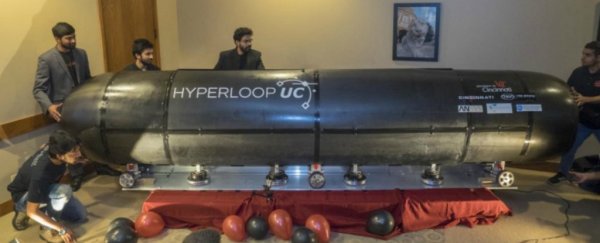A student-designed Hyperloop pod, measuring 4.2 metres (14 feet) long, levitated for the first time this week in the US, creating hope that the design will be successful come January, when the team tests the pod inside a 1.6-kilometre (1-mile) long test track.
As you can see in the video above, the team – consisting of upwards of 60 students from the University of Cincinnati – was able to get their pod to magnetically levitate about 0.63 centimetres (0.25 inches) above the ground.
"We are very proud of the design we have created," said team leader Dhaval Shiyani. "It hits all the marks with respect to performance, safety and scalability … We are confident that we will be a force to reckon with come January."
In case you missed it, the Hyperloop is a hypothetical, high-speed train-like system that uses tubes and levitation to propel travellers at breakneck speeds to their destinations.
The original idea for the Hyperloop was dreamt up by Elon Musk – Tesla and SpaceX founder/CEO – who made the blueprints open access so that teams could compete across the world to make the best design.
So far, there are more than 1,200 teams competing worldwide for a chance to get their designs fully realised.
If a prototype does work, it could potentially change the face of long distance transit, because the pods are designed to travel at roughly 1,126 kilometres per hour (700 mph) – fast enough to rival a plane.
At this speed, a person could get from New York to Los Angeles – a road distance of 4,465 kilometres (2,775miles), and about a 40-hour car ride – in roughly 4 hours, depending on the route.
The UC team's latest successful demonstration puts them in the upper-rankings – the top 30 – of teams competing to complete a potential design.
"This has been a tremendous marriage of innovation, academics and research," said UC interim provost Peter Landgren. "Hyperloop is a global conversation, and Elon Musk needs to be hearing what's going on in Cincinnati."
The next step will see the UC team's design fly down a 1.6 kilometre (1 mile) test track set in California in January where they will go up against 29 other teams.
"These are engineers, designers and business students all working side by side – just as they would in the real world. They have taken their vision, formed by a host of different minds, and together have made it a reality," said UC's College of Engineering and Applied Science dean Teik Lim.
While there are still many hurdles for the Hyperloop, as a concept, to overcome, such as how they plan on building tube systems, acquire the capital to do so, and many technical and safety challenges, it's cool to see the idea progressing so fast.
